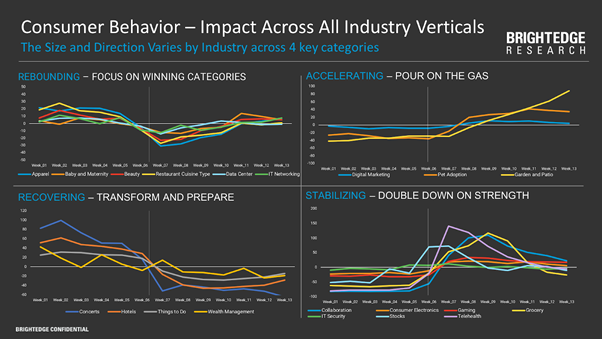30-second summary:
- Search marketing is evolving at lightning speed alongside the consumer.
- One company’s challenge can be another’s opportunity.
- Activating search and market insights has become mission-critical for brands.
- Brands need to stay on top of what’s happening with both the consumer and the SERP.
- Creating and optimizing content that enhances a consumer’s experience is key.
- Jim Yu shares five search opportunities you’ll want to have your eye on as you strategize for the rest of 2020 and beyond.
Late in 2019 and just around the new year, the anticipated SEO trends for the coming year focused on voice search, featured snippets, BERT, experiential content, and new networks like TikTok. Who could have guessed that midway through 2020, that things would have changed so rapidly?
The marketing calendar planned out 12 months ahead is shot, and some brands have had to pivot the entire business, offering new pandemic-inspired products and services, while others are still trying to navigate how to do business in keeping with the social distancing and contact-free needs of increasingly stressed consumers. Stimulus funding, unemployment, remote work challenges, childcare/schooling and more are all wreaking havoc with consumer behavior.
Of course, as with all change in the search world, one person’s challenge is another’s opportunity. You can bet that at least some competitors are going to rely on their traditional, time-consuming decision-making methods, leaving a lane wide open for agile and innovative first-movers.
Who are having to learn their market all over again? Perhaps this is why search interest in SEO itself, which was largely stagnant from mid-2017 to early this year, has ballooned. In fact, searches for SEO are at a five-year high. Companies need to know—how can I get back in front of the customers most in need of products and services like ours?
Check out these five search opportunities you’ll want to have your eye on as you strategize for the rest of 2020 and beyond.
1. Rebuilding your understanding of key markets – consumer-first marketing
Prior to the pandemic, the percentage of CPG purchases made online versus at brick-and-mortar stores was already at 11% and on a growth trajectory. Now, markets are rapidly shifting not only to online buying and e-commerce but to hybrid models such as buy online pickup in-store (BOPIS), order in-app for contactless delivery (think UberEats, GrubHub), subscription-based (HelloFresh), and others.
If you’ve tried purchasing clothes in-store lately, it can be a stressful and not at all rewarding experience. With in-store capacity limits, mask and social distancing requirements, directional arrows to guide traffic, and no changerooms in many places, ordering online has become more attractive. The risk inherent to purchasing online is that an item may not fit—well, now you may not be able to try it on anyway. Might as well stay home and try it on when it arrives.
All of this change is costing brands a lot as more staff are needed for increased sanitization, partitions and other safety barriers are installed, hand sanitizer is provided, and more. What’s more, COVID highlighted serious shortcomings in global supply chains that provide many types of goods to Americans from overseas. Companies are having to rethink every aspect of the business through this new lens of rising costs and the on-location experience not being what it was just a few months ago.
Search insights can be helpful here as you try to navigate the new market. We’re seeing that it’s not a temporary shift; analysts and experts now speak of COVID-19 restrictions in terms of months and seasons rather than days or weeks. Having your ear to the ground, so to speak, is more important than ever.
2. Staying on top of search trends in your vertical – keeping ahead of the competition
We studied the impact of COVID on search behavior by vertical and found that businesses have been similarly affected across four broad categories.
Apparel retailers, baby and maternity sellers, beauty brands, and data centers are among the first business is rebounding from the impact of COVID. There was an initial shock in these markets as lockdown took effect and the worst of the economic uncertainty took hold. However, people continue to need these products and services and they are readily available via ecommerce, BOPIS, and more.

Some verticals actually accelerated. Digital marketing, pet adoption, and garden and patio goods are all among this category. As social events were canceled, loneliness set in and pet adoption became a logical solution. Face with spending more time at home, people began investing in improving their outdoor living spaces.
In the stabilizing category, we saw consumer electronics, gaming, grocery, and telehealth explode in popularity near the beginning of the pandemic. As people learn to live with the uncertainty of what has become quite a lengthy issue, these industries are stabilizing and those companies involved need to really build on their strengths to stand out.
Of course, some industries took a real hit and it could be months or even years before they recover. Airlines, hotels, concert venues, and the related product and service providers there—these brands need to transform and prepare to weather these conditions for some time.
Whatever your vertical, it is critical that you understand what people are searching for right now and that your content is optimized for those terms. In banking, for example, searches for drive-thru ATMs have become incredibly popular. For groceries, people want to know if they can buy online and pick up in-store. Searchers are looking for contactless payment and delivery from restaurants and meal providers.
Spend time on research and check out the attributes available to your business category in Google My Business, and simply spend a bit of time searching your competitors to see how they’re adapting.
3. Reconsidering consumers’ content needs – optimizing for experiences
As McKinsey puts it, we have “covered a decade in days” as far as the adoption of digital goes. COVID-19 has caused a surge in ecommerce, declines in discretionary spending, reduced shopping frequency and a shift to shopping closer to home as consumers have sought to limit the number of trips they make to brick and mortar stores. Consumer satisfaction and ongoing viral infection rates will continue to cause dramatic fluctuations in consumer behavior.
As Kelly Askew, Managing Director of Accenture Strategy for Canada, recently told Retail Insider,
“People are saying they expect that those new behaviors are going to continue into the foreseeable future. We think that those behaviors may persist as long as a decade. The crisis is causing consumers to consider the impact of their shopping choices more closely when it comes to things like health and the environment.”
When it comes to the impact on how people search, we’ve seen that consumers’ appetite for information is as voracious as ever. One of the first behavioral changes we noted due to COVID-19 was an intense focus on quality information. Consumers are becoming more and more aware of the dangers of misinformation and bias on the web. When sharing out COVID-related information, brands need to cite and link to reputable, top-quality sources. Make it clear to readers (and to Google) that your company is committed to that expertise, authority, and trust that the search engine wants to see in the results it prioritizes for searchers.
Personalization is more important than ever. Dynamic content can help you mirror consumer intent when they are searching for or exploring your site for just the right solution for their unique needs.
4. Staying on top of search engine updates – adapting to the SERP
Probably the lowest hanging fruit in the search world is simply paying attention to what it is that search engines are looking for and focussing on delivering there. Updates and new features can tell us a great deal about how to optimize content. The whole concept of entities, for example, gives us a peek behind Google’s curtain at what it wants to see.
Google needs to be able to understand how different entities are related. Through RankBrain, it decides how important each signal that factors into that relationship really is. Google is getting more sophisticated in its ranking algorithm but at the end of the day, this is nothing new or earth-shattering for brands. It has always been the search marketer’s job to help the search engine understand why any particular webpage is a better answer to any given query than another.
There are multiple ways to demonstrate to Google how your page and your company as an entity relates to your target market searcher’s query. And again, these aren’t necessarily new.
You are going to write high-quality, focussed content. You are going to:
- Link to reputable sources and share your own expertise in an effort to try to get other reputable publishers to link to you. And again, these aren’t necessarily new
- Write high-quality, focussed content.
- Link to reputable sources and try to get other reputable publishers to link to you
- Use the proper schema markup
- Going to optimize your images properly to facilitate accessibility and also hope the search engines understand the content of those graphics
Mobile continues to be increasingly important, especially as emerging markets come online with a large proportion of the population being mobile-only. Knowing this, brands need to be looking at an even more mobile-centric future in 2021 and beyond. Mobile is no longer just alternative web design for the desktop website. Mobile is an entire experience with its own customer journey, content needs, and rich search results.
We need to be looking to voice, too, as consumers become more reliant on their voice-enabled and IoT devices. Again, we are not just adapting content for being read out loud. We are seeing entirely different types of queries when people use voice search. Content for voice search results needs to take into account the zero interface nature of the searcher. How can you deliver an exceptional experience to someone without a screen?
Brands need to be developing the strategies and at least have these issues on the horizon. You may be in crisis mode at the moment, but that is not a place you can stay forever.
5. Leveraging technology – empowering the AI assist
While many firms are now using AI-enabled tools in some way, new applications and possibilities are still developing every day. Artificial intelligence enables SEOs to not only automate tasks but to derive greater insight, make smarter decisions, and deliver on consumer needs in near to real-time at scale.
Content optimization, competitive research, SERPs analysis, keyword research, and more can all be made more efficient and effective when powered by AI. Look for solutions that provide intelligent automation and enable human SEOs on the team to focus on the more creative aspects of each campaign. It’s not about replacing people, but augmenting their performance and giving them better data and more accurate insights on which to base their decisions.
SEO will lead the way through COVID recovery for businesses of all kinds. Ecommerce, BOPIS, local business discovery, and evaluation—whatever the product or service, and whatever the service delivery model, consumers take to search engines to find the information needed to make their purchasing decisions. If anything, this trend has picked up as a result of COVID, and consumers’ need for content will continue to grow as the Coronavirus continues to impact our way of life.
Those in position to be agile and focused on getting in front of the most current opportunities in search will win the clicks—and the lion’s share of new business.
Jim Yu is the founder and CEO of BrightEdge, the leading enterprise SEO and content performance platform.

